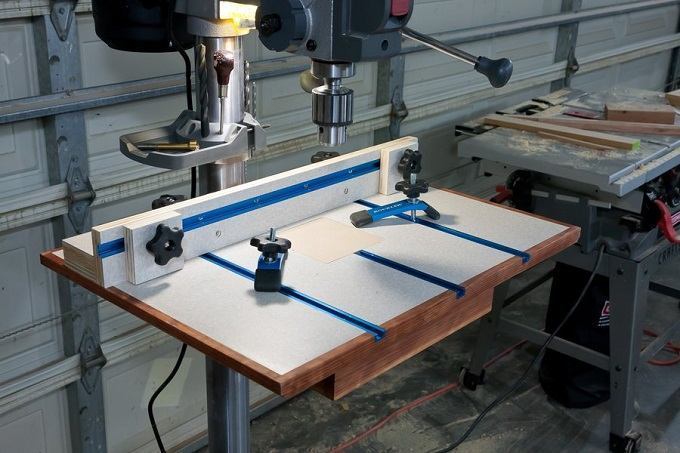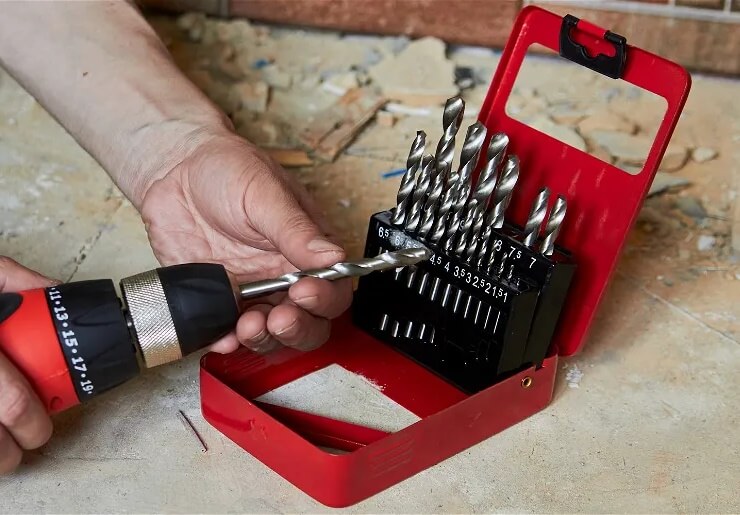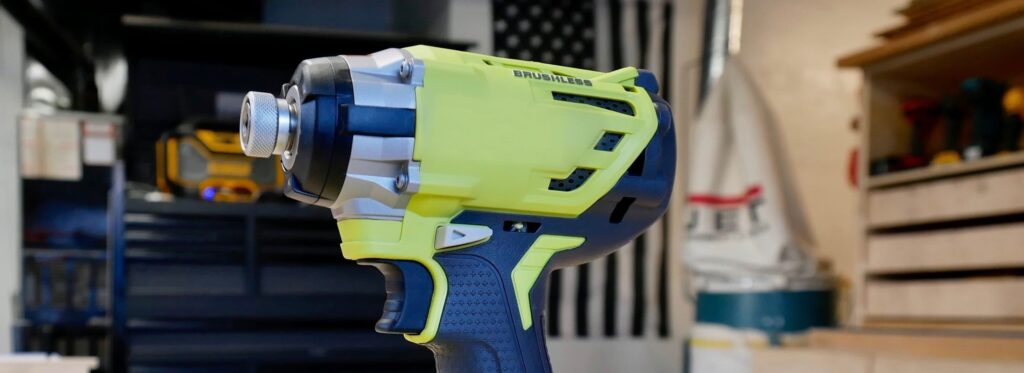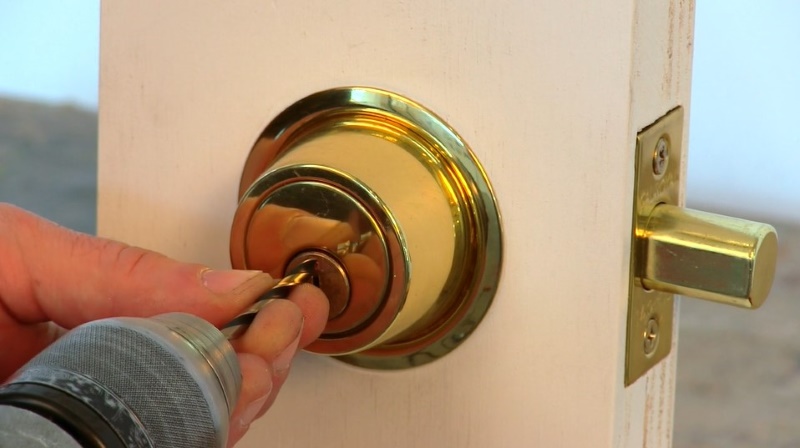To the untrained eye there isn’t much difference between a metal drill bit vs a wood drill bit, and they’re often confused with each other. There are certain elements in the design of both the metal drill bit and the wood drill bit that are tailored to their destined jobs: to drill wood, or to drill metal.
In this article will explain to you why they look so similar, how to tell the difference between metal drill bits vs wood drill bits, what types of bits there are, and we’ll answer some common questions.
A drill bit is the interchangeable, rotating part that is attached to the tool’s chuck. Using the wrong bit on the wrong material can damage the bit, your project, and maybe even cause some tears. But what determines the outcome when you have to choose between a metal drill vs a wood drill? Let’s start with what makes wood drill bits and metal drill bits look so similar.
It’s true that wood drill bits and metal drill bits look an awful lot alike, and here’s why.
Both wood drill bits and metal drill bits were designed for the same general purpose: to drill holes.
There are still countless of different types and sizes within the categories of wood drill bits and metal drill bits. These variations in detail make each drill bit even more material and project specific.
Metal and wood drill bits are interchangeable parts, making tools more versatile. Both types of bit can be used in all kinds of tools, such as milling machines, drill drivers, the best cordless drills, the best cordless hammer drills, drill presses (like the best drill presses for metal or the best drill presses for woodworking), and the normal drill. What type and size of bit you need will also depend on the equipment you’re using.
Now you understand the similarities between wood and metal drill bits. But how can you tell whether you’re dealing with a wood or a metal drill bit when looking at their differences?
To keep your drill from ‘walking’ when drilling wood, a wood drill bit has an extremely sharp point in its center, which is called a spur. The spur keeps the drill centered as is pushed through wood. It also gives a stable starting point. Most of the time, the spur will be your first clue. A metal drill bit will feature a conical cutting tip which lead into spiral-shaped flutes that drive the cut metal upwards. Another giveaway for the wood drill bit is its lip which chisels away around the perimeter of the hole. Most wood drill bits come in a shiny finish or black, but they do come in other colors as well.
A wood drill bit is instantly recognizable by its sharp point in the center of the bit, which has been designed to stabilize the bit as you drill your hole. A metal drill bit might be able to penetrate wood, but chances that you’ll drill a straight hole are slim. Another risk you take when using a metal drill bit on wood is the splintering of the material when you reach the other side.
The difference in density of metal and wood dictates how strong and dense the drill bit has to be to be. Wood drill bits are usually made out of carbide, cobalt, or high-speed steel (HSS). Metal drill bits may on occasion be made from the same material, but they’ll be coated with other materials to increase durability. In the case of metal drill bits, this is often black oxide or titanium.
The simple reason for metal drill bits needing an additional coating is because drilling into metals generates a lot of heat. That’s why metal drill bits are often coated with an extremely hard and dense metal, such as carbide, titanium, or cobalt steel.
If it’s the metal drill bit you’ll be needing, you’ll have to make the decision on what type of metal drill bit as well, depending on what the desired results are.
Twist drill bits, sometimes known as the fluted bit, all have a conical cutting tip and spiral flutes which form a twist on the bit’s axis, designed to extract the metal chips from the hole. Twist drills are made from various materials, including Cobalt, carbide, and HSS. The bright finish HSS bits are the most common type of metal bits because they are the cheapest and can be used for drilling into soft metals, wood and plastic.
When dealing with heavier metals, such as stainless steel and cast iron, it’s better to opt for a titanium drill bit with a titanium nitride coating. And if you plan on drilling into the real stuff, like Inconel, you’ll need a tungsten carbide bit or a cobalt drill bit.
Carbide and cobalt bits have one thing that puts them above titanium bits, and that is that you sharpen carbide and cobalt bits several times in order to maintain their cutting edge quality.
The step drill bit has many other names, including the UniBit, cone drill, multi drill, and it also somewhat resembles a Christmas Tree, hence that some people call the step drill the Christmas Tree drill. Its shape is unmistakable, and you’ll find it useful when drilling holes in thin sheets of metal.
Center bits have a sturdy and thick shank that doesn’t flex, which is vital in high-speed drilling. Center bits are generally used for spot drilling on lathe, drill press, and milling machines because they are incredibly hard to break and accurate. That’s why they’re mostly found in more professional settings.
Once you’re sure it’s the wood drill bit that you need, it’s time to figure out what type of wood drill but you’ll be needing. Following are some of the more common wood drill bits.
The brad point bit is probably the best-known wood drill bit out there. It’s also by far the most precise type of bit. This bit is also known as a lip and spur, because of its small spur in the tip of the drill bit. Another name this wood drill bit has been given is doweling bit.
The sharp point of the brad point bit ensures your drill isn’t going to wander and does away with the need for a pilot hole. They’re generally used in the making of furniture, doweling, and projects that require precise holes of around 1/8 inch, or 3mm, and ½ inch, or 12mm. Brad point bits work best on softwood, hardwood, and composite wood.
Paddle bits, or spade bits, are recognizable by its paddle and doesn’t have flutes. These bits are ideal when you’re drilling holes that are larger in diameter. But that’s also its weakness, because the paddle bit is also known for a rather ‘raw’ finish. To avoid the wood from ending up looking raw, or splintered completely, professionals tend to drill from both sides.
Paddle bits are often used by plumbers and electricians. They come in sizes ranging from about ¼ inch, or 6mm, and 1 ½ inch, or 38mm. The paddle bit is suitable for plywood, wood, and even some kinds of plastic.
The Forstner bit gives you a perfectly flat-bottomed hole. It has two big gullets that exact wooden chips fast, and a center spur for augmented accuracy. Typically, the Forstner bit is used when working with hardwood, plywood, or softwood and come in sizes ranging from ¼ inch, or 6mm, and 2 1/8 inch, or 54mm.
Auger bits are recognizable by their ‘corkscrew’ body and low helix angle. What makes auger bits so interesting is their screw tip in the middle, which penetrates and subsequently pulls the wood toward the bit. There are new and improved auger bits on the market now that solve the problem of clogging that may be an issue when using an auger bit.
Auger bits are perfect for the drilling of larger holes, for example when framing. They come in sizes ranging from ¼ inch, or 6mm, and 1 inch, or 25mm.
The hole saw, or hole cutter, is a circular cutter that was designed to make clean holes in various materials. Most of the time hole saws are used for wood, but they will also do the job with thin layers of aluminum and stainless steel.
Hole saws are often used when fitting pipes, and any other project that asks for the drilling of large, clean holes, and hole saw drill bits come in sizes ranging from ¾ inch, or 9mm, and 6 inch, or 152mm.
The installer bit, also known as a fishing bit or bell hanger, is an electrician’s best friend when it comes to getting wires through large pieces of wood. The installer bit gives you long, thin holes which are perfect to pull wires through. They come in sizes ranging from ¼ inch, or 6mm, and 3/8 inch, or 10mm.
Now you know how to tell the wood drill bit and the metal drill bit apart in a blink of an eye. Following we’ve answered some of the most common questions asked about metal drill bits vs wood drill bits.
Trying to use a wood drill bit on metal will instantly damage the bit and your project. A metal bit may work on wood, bit the finish will be rough and the drill might ‘walk’. In general, HSS is capable of handling soft metals, such as aluminum.
The one exception to the rule is the twist drill bit, but you still need to consider the density of the wood and choose which specific bit you need accordingly.
The flutes are how the drill disposed of the material that you’re drilling through. This means it’s important to keep an eye on length of the bit as much as what kind of bit. In general, you’ll want to make sure there is at least two times the drill diameter in flute length above the hole.
You can sharpen certain drill bits yourself once the bit starts to wear down. All you need is a belt sander or a bench grinder. Particularly Carbide tips respond well to a little TLC.
From now on, you’ll never be doubt about who wins in the battle of the metal drill bit vs the wood drill bit. Though both can be made of the same material, there are key differences that make them specific to either metals or woods. An instant giveaway of the wood drill bit is the sharp point in the middle of the bit, called the spur. Other than that, you can look at the type of material the bit is made of determine what its purpose is.





